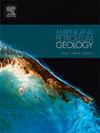Thermochronological constraints on the evolution of the Bongor Basin, Chad
IF 3.6
2区 地球科学
Q1 GEOSCIENCES, MULTIDISCIPLINARY
引用次数: 0
Abstract
The Bongor Basin is an important petroliferous basin in the Western and Central African rift system. The basin's evolution history is featured with a strong tectonic inversion during the Late Cretaceous, which resulted in its unique basin structure and hydrocarbon accumulation pattern. However, due to the complex process of repeated cooling and heating, single sample bedrock thermochronology can hardly provide accurate constraints to its thermal evolution history. In this paper, nine granitic core samples from the crystalline basement in five wells on the northern slope of the Bongor Basin were analyzed using multiple thermochronological methods (apatite U-Th/He, apatite fission tracks and length distribution, apatite U-Pb dating) as well as vertical profiles to obtain a more accurate thermal history. The results show that the samples from all five wells underwent four stages of thermal history: from ∼600 Ma to 135 Ma, the samples cooled continuously from 600 °C to near-surface temperatures; from ∼135 Ma to 100 Ma, the samples were heated rapidly; from 100 Ma to 60–80 Ma, the samples cooled rapidly; and after that, the samples experienced slow differential heating and cooling. The thermal history results show that the key time for the strong inversion of the Bongor Basin was between 80 and 90 Ma when the basin was uplifted and exhumed as a whole, while samples in different fault blocks underwent differential uplift and subsidence since the Paleogene.
乍得邦戈尔盆地演化的热时学制约因素
邦戈尔盆地是西非和中非裂谷系统中一个重要的含油气盆地。该盆地的演化历史以晚白垩世强烈的构造反转为特征,从而形成了独特的盆地结构和油气聚集模式。然而,由于反复冷却和加热的复杂过程,单一样本基岩热年代学难以对其热演化历史提供准确的约束。本文采用多种热时学方法(磷灰石 U-Th/He、磷灰石裂变轨迹和长度分布、磷灰石 U-Pb 定年)以及垂直剖面方法,分析了邦戈盆地北坡五口井中来自结晶基底的九个花岗岩岩芯样品,以获得更准确的热历史。结果表明,五口井的样品都经历了四个阶段的热历史:从600 Ma ∼ 135 Ma,样品从600 °C持续冷却到近地表温度;从135 Ma ∼ 100 Ma,样品被快速加热;从100 Ma ∼ 60-80 Ma,样品被快速冷却;之后,样品经历了缓慢的差异加热和冷却。热史结果表明,邦戈盆地发生强烈反演的关键时间是80-90Ma之间,此时盆地整体隆起和抬升,而不同断块的样品自古近纪以来经历了不同程度的隆起和下沉。
本文章由计算机程序翻译,如有差异,请以英文原文为准。
求助全文
约1分钟内获得全文
求助全文
来源期刊

Marine and Petroleum Geology
地学-地球科学综合
CiteScore
8.80
自引率
14.30%
发文量
475
审稿时长
63 days
期刊介绍:
Marine and Petroleum Geology is the pre-eminent international forum for the exchange of multidisciplinary concepts, interpretations and techniques for all concerned with marine and petroleum geology in industry, government and academia. Rapid bimonthly publication allows early communications of papers or short communications to the geoscience community.
Marine and Petroleum Geology is essential reading for geologists, geophysicists and explorationists in industry, government and academia working in the following areas: marine geology; basin analysis and evaluation; organic geochemistry; reserve/resource estimation; seismic stratigraphy; thermal models of basic evolution; sedimentary geology; continental margins; geophysical interpretation; structural geology/tectonics; formation evaluation techniques; well logging.
 求助内容:
求助内容: 应助结果提醒方式:
应助结果提醒方式:


